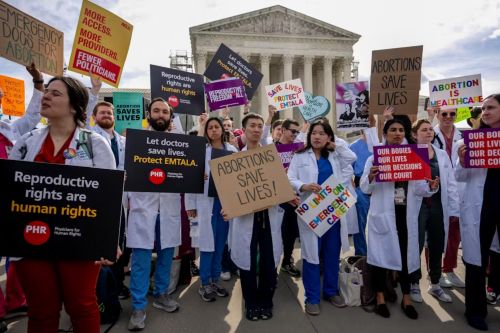

What emerges from the Trump administration and Kennedy’s HHS is not a scattered set of policies but a deliberate narrowing of reproductive autonomy, cloaked in the language of safety and fiscal discipline.

By Matthew A. McIntosh
Public Historian
Brewminate
Introduction
On a sweltering afternoon in late September, a young woman in Texas logged onto a telehealth portal, hoping to secure medication that doctors say is safe and effective when prescribed under long-standing FDA guidelines. What she found instead was uncertainty: pharmacies reluctant to dispense, clinics bracing for new restrictions, and federal officials hinting that access may soon be further curtailed. That uncertainty is no accident. Just days earlier, Health and Human Services Secretary Robert F. Kennedy, Jr. announced a sweeping “safety review” of mifepristone, the pill at the center of medication abortions nationwide, framing the move as a matter of scientific vigilance.
At the same time, President Trump has pushed through executive orders, funding freezes, and regulatory rollbacks that collectively erode reproductive health protections. Together, their actions mark a coordinated tightening of reproductive choice, policies that, critics warn, jeopardize women’s health under the guise of oversight and fiscal restraint.
RFK, Jr.’s Investigation into the Abortion Pill : What’s at Stake?
When Kennedy announced on September 25 that his department would investigate the “safety protocols” surrounding mifepristone, he framed it as a neutral act of scientific diligence. “We need to be absolutely certain about the safety of this drug,” he told reporters, casting the inquiry as a public health necessity rather than a political maneuver. Yet to many medical experts and reproductive rights advocates, the move looked less like vigilance and more like a calculated effort to undercut access.
The FDA has repeatedly affirmed the safety of mifepristone since it was first approved in 2000, with adverse effects far rarer than those associated with widely used drugs like penicillin or Viagra. Decades of peer-reviewed studies support the medication’s effectiveness in terminating early pregnancies. The American College of Obstetricians and Gynecologists has called the pill “essential health care” and warned against politically driven restrictions. Still, Kennedy’s probe threatens to shift the regulatory terrain. If the review leads to tighter restrictions on prescribing or dispensing, the result could be reduced telehealth access, fewer pharmacies willing to stock the drug, and heightened costs for patients, effects that disproportionately hit women in rural areas or states where surgical abortions are already banned.
Critics also point out that the data often cited to justify new scrutiny of mifepristone are drawn from studies with methodological flaws or lacking peer review, raising alarms that “science” is being selectively invoked to bolster an ideological agenda. The chilling effect is already palpable: some clinics have begun limiting their services preemptively, unsure of how federal oversight might evolve in the coming months. For patients who cannot travel across state lines or afford costly procedures, these barriers could amount to a near-total loss of access.
Trump’s Broader Agenda: Rolling Back Reproductive Health Infrastructure
While Kennedy’s investigation into mifepristone captures headlines, the Trump administration has been pursuing a broader strategy that systematically weakens reproductive health care. Early in 2025, the administration froze roughly $66 million in Title X funding to Planned Parenthood and other providers, a blow to low-income women who depend on subsidized contraception and preventive services. At the same time, new budget proposals targeted women’s health research, including studies on maternal mortality, menopause, and fibroids, under the banner of fiscal restraint.
Trump’s actions have gone beyond funding. In January, he signed Executive Order 14182, directing federal agencies to strictly enforce the Hyde Amendment and roll back policies that had allowed some flexibility in using federal funds for abortion-related services. The order effectively ended longstanding workarounds, shutting off federal support for providers that offer abortion alongside other critical reproductive care. The administration also revoked guidance requiring hospitals to provide emergency abortions under federal EMTALA law in states with strict bans, opening the door for doctors to face legal jeopardy even in life-threatening cases.
Taken together, these measures amount to a quiet dismantling of the reproductive health safety net. Medicaid patients have seen access to preventive services narrowed, clinics dependent on Title X funds have reduced hours or closed, and hospitals are left uncertain about their obligations in medical emergencies. For women in states that have layered Trump-era federal rules on top of restrictive local laws, the result is a narrowing corridor of care that advocates warn is both dangerous and discriminatory.
Connecting the Dots: A Strategy of Restriction Under Scientific Pretext
At first glance, Kennedy’s “safety review” and Trump’s funding rollbacks might appear as separate initiatives, one framed as regulatory oversight, the other as fiscal discipline. Yet together they reveal a common strategy: deploying the language of science and governance to achieve ideological ends. By casting mifepristone as a potential risk, Kennedy provides cover for restrictions that have long been sought by abortion opponents. By labeling research and health programs as unnecessary expenditures, Trump advances a broader agenda that narrows women’s choices while sidestepping the language of outright bans.
Medical experts warn that such tactics weaponize uncertainty. When federal officials raise doubts about a drug the FDA has long deemed safe, providers and patients alike may second-guess its use, even absent new evidence. The same effect applies to funding cuts: when essential clinics lose support, women face longer wait times, higher costs, or outright denials of care. In both cases, the consequences fall hardest on low-income women, women of color, and those in rural areas with few alternatives.
The pattern is not new. Advocates note that invoking “science” to justify restriction mirrors strategies seen in vaccine skepticism and misinformation campaigns, issues both Kennedy and Trump have been linked to in the past. By presenting ideology as technical oversight, the administration gains plausible deniability while shifting the burden onto patients and providers. What emerges is less a patchwork of individual policies than a coherent design: limit access, heighten confusion, and reduce reproductive choice under the guise of prudence.
Prognosis and Possible Futures
If left unchecked, the combined effect of Kennedy’s regulatory probes and Trump’s policy shifts could transform reproductive health in the United States within just a few years. Stricter oversight of mifepristone would almost certainly shrink access to medication abortion, particularly in states where surgical procedures are already banned. Clinics that once relied on Title X funds may continue closing, leaving entire regions without affordable reproductive health providers. And the rollback of EMTALA guidance means that even women facing life-threatening complications could be denied care in hospitals wary of legal retaliation.
Legal battles are already underway. Several states and advocacy groups have filed lawsuits challenging the administration’s funding restrictions and executive orders, while medical associations continue to publish evidence reinforcing the safety of mifepristone. These cases may provide temporary relief, but they also highlight how access to reproductive health has become dependent on the courts rather than guaranteed by federal policy. The outcome, advocates warn, is a patchwork system where geography and income determine the boundaries of choice.
The stakes extend beyond abortion. By targeting the infrastructure of women’s health (research funding, preventive care, emergency treatment) the administration risks worsening maternal mortality rates, deepening racial disparities in healthcare, and discouraging providers from entering already underserved areas. As critics emphasize, what is framed as “oversight” today could leave lasting scars on women’s health for a generation.
Conclusion
What emerges from the Trump administration and Kennedy’s HHS is not a scattered set of policies but a deliberate narrowing of reproductive autonomy, cloaked in the language of safety and fiscal discipline. Each move, whether an “investigation” into a pill the FDA has long certified as safe, or a funding freeze that shutters clinics, pushes women further from the care they need. The cumulative effect is a system where reproductive health becomes a privilege of geography and wealth rather than a basic right.
Critics warn that these policies do more than curtail choice; they endanger lives. By erecting barriers under the guise of oversight, the administration risks driving women toward unsafe alternatives, worsening health outcomes, and deepening inequality. The battle over reproductive rights in 2025 is thus not simply about abortion; it is about whether women’s health will be safeguarded by evidence-based policy, or sacrificed to ideology masquerading as science.
Originally published by Brewminate, 09.30.2025, under the terms of a Creative Commons Attribution-NonCommercial-NoDerivatives 4.0 International license.


